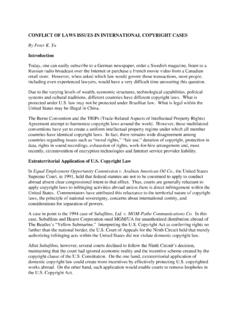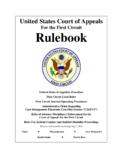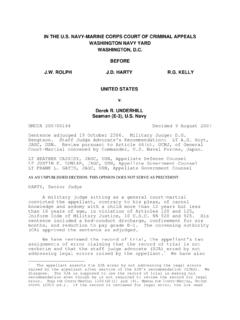Transcription of THE OBJECTIVES AND PRINCIPLES OF THE TRIPS …
1 THE OBJECTIVES AND PRINCIPLES OF THE TRIPS AGREEMENT Peter K. Yu* Introduction The Agreement on Trade-Related Aspects of Intellectual Property Rights ( TRIPS Agreement) is one of the more controversial international intellectual property agreements that have entered into force. Its negotiations were highly contentious, and the perspectives of developed and less developed countries on the role of intellectual property protection and enforcement remain far apart. In recent years, less developed countries including both developing and least developed countries have expressed their deep dissatisfaction with the way the Agreement has been interpreted and implemented. They are also frustrated by the ongoing demands by developed countries for protections that are in excess of what they promised during the TRIPS negotiations often through new bilateral and regional trade and investment agreements.
2 As they claim, the Agreement as interpreted by their developed trading partners and the additional TRIPS -plus demands ignore their local needs, national interests, technological capabilities, institutional capacities, and public health These concerns and frustrations eventually led to the establishment of a set of development agendas at the WTO, the World Intellectual Property Organization (WIPO), and other international Although the TRIPS Agreement s one-size-fits-all or, more precisely, super-size-fits-all approach is highly problematic, the Agreement, in its defense, includes a number of flexibilities to facilitate development and to protect the public interest. To safeguard these flexibilities, Articles 7 and 8 provide explicit and important OBJECTIVES and PRINCIPLES that play important roles in the interpretation and implementation of the Agreement.
3 This Chapter explores the origins of these two provisions and the roles they can play in promoting the development goals of less developed countries. * Copyright 2009 Peter K. Yu. This Chapter was abridged and adapted from Yu, Peter K. (2009), The OBJECTIVES and PRINCIPLES of the TRIPS agreement , Houston Law Review, 46: forthcoming. 1 Yu, Peter K. (2007), The international enclosure movement , Indiana Law Journal, 82(4): 827 907, 828. 2 Yu, Peter K. (2009), A tale of two development agendas , Ohio Northern University Law Review, 35(2): 465 573. THE OBJECTIVES AND PRINCIPLES OF TRIPS 2 The Chapter begins by tracing the development of Articles 7 and 8 of the TRIPS Agreement. By recounting their historical origins and subsequent developments, it shows that, even though only a small amount of the treaty language proposed by less developed countries was included in the final text of the Agreement, the choice of such language in Articles 7 and 8 may provide less developed countries with important tools for restoring the balance of the international intellectual property system.
4 The Chapter then examines the normative content of Articles 7 and 8 of the TRIPS Agreement. It highlights the interpretations made by WTO panels and the Appellate Body and the implications of the two declarations adopted during the Fourth WTO Ministerial Conference in Doha (Doha Ministerial). The Chapter concludes by exploring the multiple roles Articles 7 and 8 can play in facilitating a more flexible interpretation and implementation of the TRIPS Agreement. It also explains how less developed countries can use these provisions to preserve the hard-earned bargains they won through the TRIPS negotiations. Origins and development The TRIPS negotiations The negotiations of the TRIPS Agreement began with the Ministerial Conference of the General Agreement on Tariffs and Trade (GATT) in Punta del Este, Uruguay. Held in September 1986, the conference came at a critical point in time when the negotiations between developed and less developed countries over the revision of the Paris Convention for the Protection of Industrial Property (Paris Convention) was deadlocked at During that ministerial conference, the GATT contracting parties set out their negotiating OBJECTIVES for the new Uruguay Round, which included the establishment of a new multilateral intellectual property agreement.
5 In the beginning, many less developed countries naively believed they could use the text of the Punta del Este Declaration to limit the negotiations primarily on trade in counterfeit goods and other such trade-related aspects .4 As these countries claimed, the GATT mandate did not allow for the discussion of substantive issues on intellectual property rights. Led by Brazil and India, these countries insisted that only WIPO had the institutional competence to discuss those issues. However, as Jayashree Watal, a former negotiator for India, pointed out, This was a misreading not only of the text but also of the writing on the wall. Clearly, the negotiations were aimed not only at clarifying GATT provisions but elaborating, as appropriate , new rules and disciplines. 5 By the early 1990s, virtually all negotiating parties accepted as inevitable the inclusion of minimum standards for intellectual property protection and enforcement in the GATT 3 Yu, Peter K.
6 (2004), Currents and crosscurrents in the international intellectual property regime , Loyola of Los Angeles Law Review, 38(1): 323 443, 357 58. 4 Watal, Jayashree (2001), Intellectual Property Rights in the WTO and Developing Countries, The Hague and Boston: Kluwer Law International, p. 21. 5 Id. THE OBJECTIVES AND PRINCIPLES OF TRIPS 3 Such a change of attitude was largely the result of the United States aggressive strategies toward the hardliner opposition countries, its successful divide and conquer tactics, the economic crises confronting many of these countries, and the successful lobbying of the European Communities, Japan, and the United States by global intellectual property By the time Canada proposed to create a new multilateral trade organization in October 1990, its proposal, along with the less developed countries fears of being excluded from such an organization, effectively ended the debate on the earlier developing country position of WIPO as the appropriate forum for lodging the results of the TRIPS negotiations.
7 8 What remained in the negotiations were the details of these new standards and how these standards were to be incorporated into the new Agreement without adversely affecting the protections already put in place by the extant international intellectual property conventions. To expedite the negotiation process, and to bring the positions of developed and less developed countries closer to each other, the GATT Secretariat and Chairman Anell prepared what was commonly referred to as the Anell Draft. This draft was later formalized as the Chairman s Report to the Group of Negotiation on Goods. As Professor Gervais, who was working at the Secretariat at the time of negotiations, recounted in detail: In the first few months of 1990, a number of industrialized countries tabled, with little advance notice, draft legal texts of what they saw as the future TRIPS Agreement. Prior to the tabling of these texts, the discussions had focused on identifying existing norms and possible trade-related gaps therein, but the emerging outline of a possible TRIPS result had essentially been at the level of PRINCIPLES , not legal texts.
8 The draft legal texts, which emanated from the European Community, the United States, Japan, Switzerland, and Australia, foreshadowed a detailed agreement covering all IP rights then in existence, even the seldom used sui generis protection for computer chips. The proposals also included detailed provisions on the enforcement of those rights before national courts and customs authorities and a provision bringing future TRIPS disputes under the General Agreement on Tariffs and Trade ( GATT )/WTO dispute-settlement umbrella. These proposals were far from obvious in light of the limited mandate of the TRIPS negotiating group. As a reaction, more than a dozen developing countries proposed another legal text, much more limited in scope, with few specific normative aspects. They insisted on the need to maintain flexibility to implement economic and social development OBJECTIVES .
9 In retrospect, some developing countries may feel that the Uruguay Round Secretariat did them a disservice by preparing a composite text, which melded all industrialized countries proposals into what became the A proposal, while the developing countries text became the B text. The final Agreement mirrored the A text. As such, it essentially embodied norms that had been accepted by industrialized countries. The concerns of developing countries were reflected in large part in two provisions Articles 7 and 6 Yusuf, Abdulqawi A. (2008), TRIPS : Background, PRINCIPLES and general provisions , in Carlos M. Correa and Abdulqawi A. Yusuf (eds), Intellectual Property and International Trade: TRIPS Agreement, 2nd edn, Alphen aan den Rijn: Kluwer Law International, pp. 3 21, 9. 7 Sell, Susan K. (2003), Private Power, Public Law: The Globalization of Intellectual Property Rights, Cambridge and New York: Cambridge University Press; Watal, supra note 4, at 19; Yu, Peter K.
10 (2008), Access to medicines, BRICS alliances, and collective action , American Journal of Law & Medicine, 34(2): 345 94, 365; Yu, supra note 3, at 412 13. 8 Watal, supra note 4, at 34. 9 Gervais, Daniel J. (2005), Intellectual property, trade & development: The state of play , Fordham Law Review, 74(2): 505 35, 507 08. THE OBJECTIVES AND PRINCIPLES OF TRIPS 4 The Chairman s Report was later followed up by the text included in the Dunkel Draft a take it or leave it final draft of the TRIPS Agreement advanced by Arthur Dunkel, GATT s Director General, that constituted the Secretariat s best judgment of what would be acceptable to all of the negotiating Although Dunkel s approach, and the linkage between trade and intellectual property, was and remains controversial, his approach proved to be effective, and the negotiations concluded quickly. In April 1994, the TRIPS Agreement was adopted with very minor changes as Annex 1C of the Marrakesh Agreement Establishing the World Trade The WTO panel s clarification Since the TRIPS Agreement entered into force on January 1, 1995, WTO member states have explored the use of Articles 7 and 8 to support their positions.





